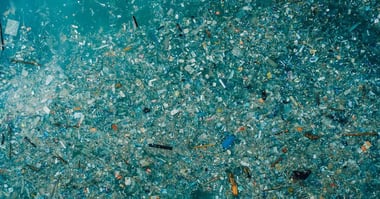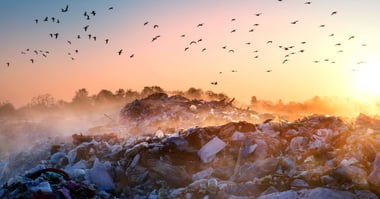
Tamara Davison
Tamara Davison is a journalist who specializes in sustainability and the environment. Reporting from around the world, she's seen firsthand the direct impact waste is having on coastal communities and our oceans. As a diver trained in ecological monitoring, the changes Tamara has seen in marine habitats inspired her to action. She's previously written for The Guardian, The Independent and the Evening Standard. She's also produced environmental documentaries for EuroNews.
Imagine a world without plastic — one where our oceans are pollution-free, and we don’t worry about microplastics in our food.
This was a reality only 120 years ago.
Plastic’s rise to prominence in just over a century has been unprecedented. It has revolutionized many sectors, emerging as a material the world can’t live without.
However, this comes at a price. The plastic pollution crisis emerged almost as quickly as the material itself, and the natural world can’t keep up.
So when did plastic become problematic? Here are the key moments in plastic history and what this means for the future.
What’s on this page?
01 | The history of plastic: a step-by-step explanation
02 | The invention of plastic
03 | The rise of synthetic plastic
04 | The plastic boom
05 | Plastics are becoming an environmental problem
06 | The future of plastic
07 | Summary
The history of plastic: a step-by-step explanation
Plastic is a broad term that describes a range of materials containing synthetic polymers in their makeup.
The novelty and versatility of this artificial material led to rapid adoption, which has continued to accelerate over the years. Its history has four distinct chapters — let’s take a look at them.
The invention of plastic
For centuries, humans relied on animal-based materials, such as ivory and tortoise shells, to create items we now commonly associate with plastic like combs, hair accessories, and game pieces.
Inventors started working on alternative solutions when those natural materials started running in short supply (and jeopardizing the natural world).
The plastic industry was exciting at this time. After all, humans were on the cusp of creating their own materials for the first time.
1862
Alexander Parkes, an inventor from Birmingham, United Kingdom, was one of the first people to create partially synthetic fabric.
In 1862, he created Parkesine, a semi-synthetic material from cellulose nitrate. Scientists could alter the material to make it rigid, soft, or even rubber-like, setting a precedent for the plastic future.
1869
In the mid-1800s, up to 100,000 elephants were slaughtered a year as demand for ivory billiard balls soared.
Inspired by a New York business offering $10,000 to whoever could create an alternative to ivory, John Wesley Hyatt answered the call. Through heat, pressure, and a combination of cellulose nitrate and camphor (two organic materials found in plant cells and tree bark), celluloid was born.
This semi-synthetic material quickly became an alternative to ivory and an attractive solution for photographic film. It wouldn’t be until almost 50 years later that the world’s first fully synthetic plastic was born.
1907
At the turn of the 20th century, Belgian chemist Leo Baekeland invented Bakelite, a smooth, heat-resistant material much like the hard plastics we know today.
The commercially successful material was revolutionary, as it could be molded into various shapes and was resistant to electricity and heat. It was dubbed the “Material of a Thousand Uses” and marked the start of the world’s obsession with plastic.
So when did this group of materials become, well, plastic?
The term 'plastic' comes from the Greek word 'Plastikos,' meaning easily molded into shape. As these new materials emerged on the market, the media reportedly started collectively branding them plastic — and the rest is history.

The rise of synthetic plastic
In its early development, plastic was transformative. This durable material was mainly used for long-lasting objects like radios, telephones, saucepan handles, and plug sockets.
Inventors and chemical engineers created countless other plastic variations over the following years, offering different strengths and uses.
It also showed considerable benefits in the health industry, which was particularly valuable during the two world wars.
1912
A German inventor patented polyvinyl chloride (PVC) shortly before World War I. Further developments made the material more flexible, allowing it to be marketed as a water-resistant fabric coating.
The building and construction industry soon adopted PVC, and it was used to insulate electric cables on military ships.
1933
The world’s most common type of plastic, Polyethylene, was accidentally discovered in the 1930s.
Two chemical engineers, Eric Fawcett and Reginald Gibson, were conducting experiments on ethylene when one of their samples leaked, creating polyethylene overnight.
1935
A famous chemical company called DuPont introduced the world to Nylon, initially marketed as a replacement for silk.
This transformed the clothing industry (in particular due to its Nylon stockings), offering an affordable solution to costly garments. Other items like brushes, fishing lines, and surgical threads quickly followed.
1941
PET (Polyethylene Terephthalate) was first developed in the 1940s before DuPont bought the patent. This material led to a boom in polyester clothing and liquid-suitable containers.
The plastic boom
From the 1960s onwards, plastic replaced virtually every material on the market. With so many uses, the affordable materials quickly became a household staple and a business must.
The plastic market surged, and chemical and petroleum companies that manufactured the material vastly benefited. Alongside this, single-use plastic also grew in popularity.
The planet was producing and throwing away mountains of plastic, with shoppers largely unaware of its long-term impact.
Some companies did know of the health and environmental risks of plastic — and chose to suppress the information. For example, Exxon and Chevron knew about the crisis of plastic pollution and climate change, and continued to push their agendas for financial gain.
1960
A Swedish company called Celloplast created the world’s first plastic bags out of polyethylene (which chemists had accidentally made 30 years earlier).
In the following decades, several prominent supermarkets adopted plastic bags in their stores for easy use, replacing paper alternatives.
1972
In the early 1970s, a journal called Science published its first study on marine plastic debris.
Other studies detected plastic within marine life, and many reports suggest the petrochemical industry knew about the risks by the 1970s. Despite this knowledge, the industry did nothing, and the pollution continued.
1978
At the start of the decade, Nathaniel C. Wyeth released the world’s first patented PET plastic bottle.
A few years later, Coca-Cola unveiled its first carbonated drink in 2-liter plastic bottles. While it was marketed as ‘recyclable,’ the necessary infrastructure or information about plastic bottles' adverse environmental effects wasn’t publicly available.

Plastics become an environmental problem
Preliminary studies highlighted plastic's negative impact on the environment as early as the 1970s. But this information only started to emerge as public knowledge some decades later.
By the time consumers became aware of the planet’s plastic crisis, it was already too late. Our oceans were already overwhelmed by plastic waste, and plastic was already mounting in landfills.
1997
Almost 30 years ago, Charles Moore was blown off path while sailing to Santa Barbara and drifted into a field of debris in the ocean. He had just discovered the Great Pacific Garbage Patch, one of five major trash zones in our world’s oceans.
2010
Bioplastics have existed for some time, but manufacturers only recently started implementing them as alternatives to synthetic plastic.
In 2010, Algopack became the first company to use seaweed to make plastic packaging, signaling a growing desire to find alternative solutions to unsustainable plastic levels.
2019
The planet produced 459 million tons of plastic in 2019 alone, showing a steady increase in production year on year despite growing awareness of the environmental risks.
At this point, we know that over 90% of plastic isn’t recycled, and is often mismanaged instead.
2020
Only recently have the impacts of plastic on human health become a concern. Scientists detected microplastics in human placentas for the first time a few years ago.
Studies are still ongoing, but scientists know that microplastics that come from plastic can enter the human body, and may contribute to adverse health effects.
The future of plastic
Nations, businesses, and consumers have increased recycling efforts over the last few years to take ownership of their plastic legacy.
However, virgin plastic production continues on an unprecedented scale, with some estimates suggesting production could trip by 2060.
Exacerbated by mass production and the disposable design of single-use plastics, the plastic industry increasingly threatens the environment and human health.
Some key developments and legislation could change that.
2020s
Since the 2020s, a lot of technical innovations have emerged that offer new approaches to sustainability. This includes exciting projects like the Bubble Barrier, which collects waste floating in our waterways, and plastic credits that help fund waste collections. We’re seeing more investments and developments in sustainable tech, pointing to promising future innovations.
2021
The European Union announced its first ban on single-use plastic items, prohibiting access to plastic plates, straws, cutlery, and cotton buds.
In 2024, the EU took this one step further by proposing a ban on single-use plastic wrapping on fruit and vegetables as part of a new green packaging treaty.
2022
At the United Nations Environment Assembly, 175 nations agreed to create a Global Plastics Treaty to end plastic pollution. The group set November 2024 as the deadline to make the legally binding agreement, which will culminate in a series of talks in Korea.
2025
By next year, businesses in EU member states will need to adhere to the newly updated Packaging and Packaging Waste Regulation (PPWR). This legislation is designed to reduce packaging waste, enhance recycling, and encourage businesses to work toward a circular economy.
Summary
From a surprising invention to a common feature of modern-day life, the story of plastic is nothing short of incredible.
It shows us that the whole world can be transformed in just a few short decades when presented with a solution that makes our lives easier.
But could we curb plastic’s impact with the same speed and scale?
As the plastic crisis becomes increasingly impossible to ignore, we’re hopeful that momentum in technology and regulation will continue to grow, mobilizing a more sustainable future — one where plastic is managed responsibly as part of a global circular economy.
It's up to us how this article continues. Let's write the future together.
Want to reduce your brand’s plastic waste footprint? Check out our guide on Capturing the Conscious Consumer and discover how to introduce a sustainable business strategy that supports the planet.

%20(1).webp)

.webp?width=380&name=Plastic-pollution-surface-of-water%20(1).webp)
%20(1).webp?width=380&name=Plastic-on-the-beach%20(2)%20(1).webp)
.webp?width=380&name=Colourful%20corals%20(1).webp)
.webp?width=380&name=solar-collection%20(1).webp)

.webp?width=380&name=Paper-packaging%20(1).webp)
.webp?width=380&name=River%20waste%20(1).webp)

.webp?width=380&name=recycling%20(1).webp)
